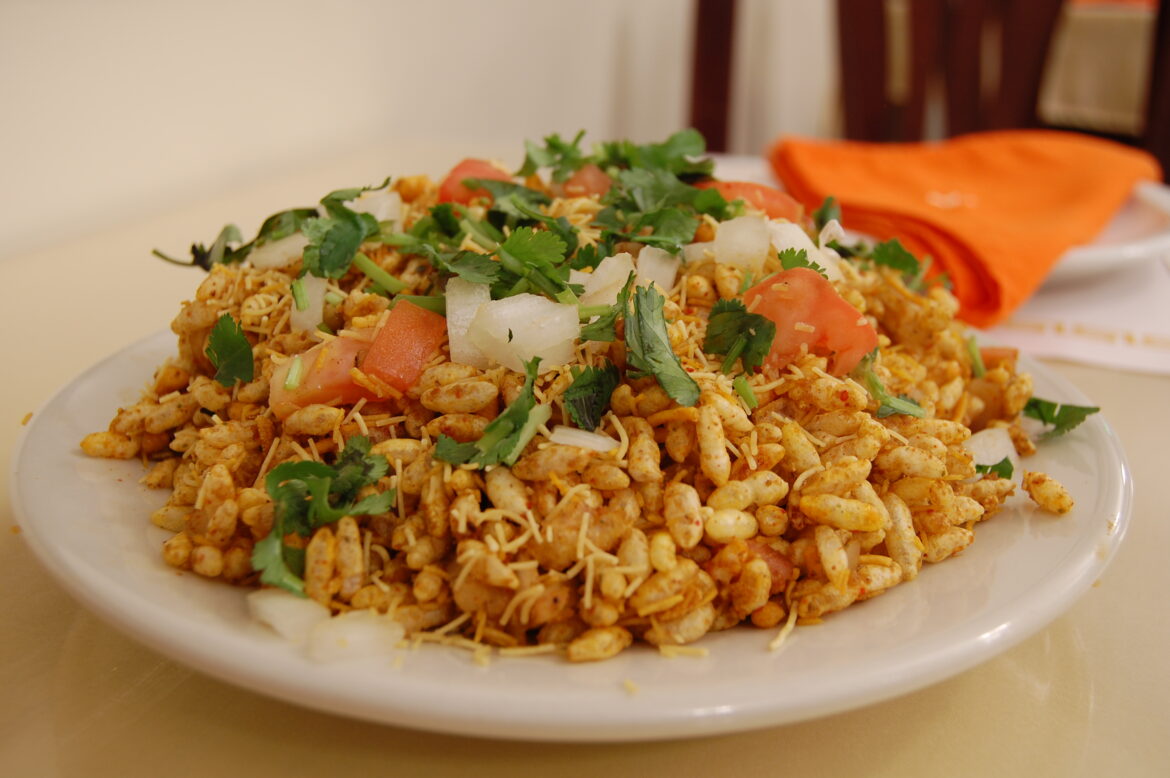If there is one culinary creation that perfectly encapsulates the chaos, creativity, and cultural complexity of North India, it is chaat. Born on the noisy, vibrant streets of cities like Delhi, Agra, Lucknow, and Varanasi, chaat is not merely a dish—it is an emotional experience, a tapestry of flavor woven together by spice, tang, crunch, sweetness, and zest. It is food that doesn’t just feed the body, but electrifies the senses. From the moment the vendor assembles the components with theatrical flair to the explosive sensation of the first bite, chaat is North India’s most exuberant answer to gastronomy. It’s not meant to be refined or minimalistic. Chaat is loud, unapologetic, and dramatic—just like the region it represents. And within its humble paper plate or eco-friendly dona, chaat contains centuries of evolution, regional variation, and culinary storytelling that defies easy categorization.
At its core, chaat is about contrast and balance, a dance between opposing forces. It brings together the crispiness of fried elements like papdi (crunchy wafers), sev (fried gram flour noodles), or puris (puffed shells), and juxtaposes them against soft, yielding ingredients like boiled potatoes, chickpeas, or yogurt. Add to that the vibrant tang of tamarind chutney, the freshness of coriander-mint paste, a splash of lemon juice, the earthy undertones of roasted cumin powder, and the bold zing of chaat masala, and you have a combination that is equal parts art and alchemy. The taste is never singular—it is layered, multi-dimensional, and fast-paced, much like the streets where it is served. In one mouthful, you may experience sweetness, heat, salt, crunch, and coolness. No two bites taste the same, and no two vendors make it alike. Chaat, in that sense, is the most democratic of Indian foods, shaped by the hands and tastes of those who serve it and those who devour it.
The word “chaat” itself derives from the Hindi verb chaatna, meaning “to lick.” Indeed, chaat is so addictive that it often compels the eater to lick their fingers, their plate, sometimes even their memories, long after the last morsel is gone. And this isn’t mere hyperbole. In a land where culinary traditions are passed down orally and often unrecorded, the evolution of chaat reflects centuries of adaptation, migration, and fusion. Its earliest origins are believed to trace back to the royal kitchens of Mughal India, particularly in the courts of Shah Jahan, when a combination of digestive spices and tangy tamarind was prescribed by hakims (royal physicians) to aid in digestion during Delhi’s hot summers. What began as a form of medicinal gastronomy soon took on a life of its own, trickling from palaces to bazaars, mutating into dozens of variants as it moved from one city to another. And today, chaat isn’t just North Indian; it is pan-Indian, global even, with interpretations found in New York food trucks, London restaurants, and Dubai food festivals.
One of the reasons chaat holds such cultural importance is its ability to localize. Walk through the lanes of Lucknow and you’ll be offered Tokri Chaat, a visual marvel where a basket-shaped potato shell holds a riot of fillings. In Delhi’s Chandni Chowk, you’ll taste Dahi Bhalla, where soft lentil dumplings swim in creamy yogurt, offset by sweet chutney and spicy masala. In Agra, Bhalla Chaat is given a crunchier twist, while in Kanpur and Banaras, the humble Tamatar Chaat surprises with the sweet-savory burst of spiced tomatoes cooked to melt-in-your-mouth perfection. Even the same variety, say Pani Puri or Golgappa, shifts dramatically across regions: filled with boiled potatoes and mint water in Delhi, chickpeas and imli in Banaras, and even sprouts and spicy buttermilk in Mumbai. This fluid identity of chaat—its ability to absorb, adapt, and reinvent—makes it less a dish and more a culinary philosophy.
But beyond the taste and texture, chaat is a cultural ritual, a social equalizer, and a sensory theatre. It is never eaten in isolation. One rarely orders just one plate or eats chaat in silence. It is meant to be consumed standing at a busy stall, surrounded by the aromas of fried dough and roasting spices, amid conversations and chaos. Families, college friends, office colleagues, tourists, and lovers all gather around the same chaatwala, united by a craving that transcends demographics. The vendor, often a performer in his own right, juggles plates, spoons, and spices with dazzling speed, guided not by recipe books but by instinct honed over years. His hands move in rhythm as he asks for your preferred level of spice, doles out an extra dash of imli if you plead, and knows exactly when to serve the next hot puri filled with pani before it bursts. It’s an interactive culinary performance, as satisfying to watch as it is to taste.
The ingredients of chaat are deceptively simple, but it’s the skillful combination that elevates them into something magical. Tamarind, used in pulp or chutney form, provides the base acidity. Yogurt lends creaminess and cooling contrast. Fresh herbs like mint and coriander give brightness, while finely chopped onions, green chilies, and tomatoes introduce a sharp, crunchy freshness. Chaat masala—an iconic spice blend made from black salt, dried mango powder, cumin, and asafoetida—binds everything together with its unmistakable umami punch. Each region swears by its own variant, some leaning more on garlic, others on sweetness, some dry, others slathered in sauce. Yet the architecture of chaat remains constant—a structure built to overwhelm and please all five senses at once.
What makes chaat particularly relevant in today’s culinary world is its timelessness and trend-resilience. While food trends come and go—kale smoothies, fusion sushis, rainbow bagels—chaat holds its ground because it fulfills a deep-rooted human craving for variety, intensity, and satisfaction. It doesn’t pretend to be healthy, but it offers something even more essential—balance. The acids aid digestion, the spices stimulate the palate, the textures excite the tongue, and the diversity of ingredients makes every bite different. It’s no wonder then that even in modern, Instagram-driven culinary landscapes, chaat continues to dominate—with gourmet chaats appearing on five-star menus and Michelin chefs drawing inspiration from its layered complexity. And yet, for all its fame, chaat remains loyal to its roots, best enjoyed not with silver cutlery but from the vendor you trust, under open skies, and with fingers itching for one more scoop.
To understand North India, one must understand chaat—not just as a food but as an institution, a memory machine, and a reflection of regional identity. It’s what children crave after school, what tourists search for when they land in Delhi, what old friends reminisce over, and what vendors perfect over lifetimes. In an age of fast-food chains and homogenized menus, chaat is a rebellion of flavor, a reminder that street food is not second-tier but sacred, that taste does not need formality, and that joy can be served in a bowl of crushed puris and mashed potatoes. It is no exaggeration to call chaat one of the greatest culinary inventions of the Indian subcontinent—because within its messy, spicy, tangy embrace lies a portrait of India itself: diverse, unpredictable, passionate, and profoundly delicious.
Conclusion: Chaat as the Soulful Symphony of North Indian Street Food
In the ever-evolving narrative of Indian cuisine, where regional specialties compete for recognition and global fusion trends challenge age-old traditions, chaat remains the unshakable constant—a dish that defies both culinary snobbery and the limits of definition. To describe chaat merely as a “snack” would be a grave understatement; it is far more than a food category. Chaat is a story, an emotion, a living and breathing institution born from the busy arteries of North India’s streets, honed over centuries by trial, trade, and taste, and passed from one generation of vendors to the next like a sacred culinary inheritance.
What makes chaat so timelessly compelling is its ability to be deeply rooted in regional traditions, yet universally relatable. There is a kind of democratic intimacy in the act of standing around a bustling street-side stall, elbow to elbow with strangers, eyes wide with anticipation, ears tuned to the sizzle of frying aloo tikki or the pop of a golgappa being pierced and filled with spiced water. In that moment, the eater becomes part of something bigger—an edible ritual that has played out for decades across cities, towns, and dusty junctions. Unlike many forms of high cuisine which rely on exclusivity and refinement, chaat thrives in chaos and inclusivity. It embraces imperfection, celebrates spontaneity, and offers a burst of flavor that is uniquely personal and yet communally cherished.
Beyond the sensory feast it offers, chaat is a metaphor for India’s cultural and gastronomic diversity. It draws from the rich tapestry of spices, textures, and ingredients native to the subcontinent. A single serving of chaat may involve up to twenty ingredients, each bringing its own dimension—crispy puris, boiled legumes, spiced potatoes, chutneys of tamarind and mint, yogurt, onions, masalas, and finishing garnishes of pomegranate or sev. And yet, despite this apparent complexity, there is a magical cohesion to it all, a finely tuned balance that only a skilled vendor or seasoned home cook can orchestrate. That in itself is chaat’s quiet genius: the ability to make intricate harmony from seeming disorder, much like the region it represents.
Chaat also tells us stories—stories of migration, of Mughal influence and Ayurvedic theory, of seasonal changes, and of local preferences passed down through word of mouth rather than recipe books. It has survived colonization, globalization, and commercialization. It has adapted to dietary restrictions, inspired gourmet reinterpretations, and crossed borders to become a beloved representative of Indian street food in the international culinary arena. And yet, its most profound impact remains closest to home. In school memories of after-class hangouts, in neighborhood gossip sessions, in romantic street-side rendezvous, in quick evening bites and celebratory outings, chaat is woven into the social and emotional fabric of North India, not just as sustenance, but as a shared joy.
Perhaps that is the true reason why chaat endures—not merely because it tastes spectacular, but because it evokes a sense of belonging. It invites connection. It asks you to participate, to personalize your spice level, to share, to return for seconds, to remember the vendor’s face, to bring others next time. It is not food meant to be consumed in solitude or silence. Chaat insists on company, on chaos, on conversation. It is a celebration of life, with all its vivid contradictions and beautiful messiness, served in a paper plate.
So, whether you find yourself wandering the ancient alleys of Varanasi, navigating the colonial lanes of Delhi, or exploring the regal corners of Lucknow, know that you haven’t truly experienced North India until you’ve paused your journey for a plate of chaat. It may be brief in serving time, but its aftertaste lingers in your senses, memory, and heart far longer than any sit-down meal ever could. Because chaat is not just something you eat—it’s something you feel, crave, and relive. And in every spoonful, it whispers the same message: welcome to North India, where flavor meets history, and food speaks the language of the soul.
Learn More


